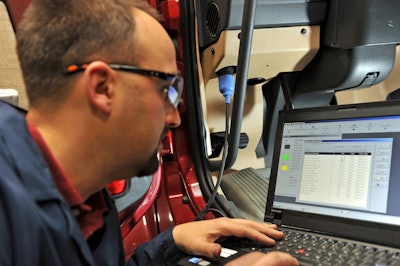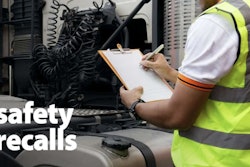
As key systems in commercial vehicles, maintenance of antilock braking systems is vital to proper truck and trailer performance. Technicians who understand how ABS works are best prepared to service the equipment in the field and react intelligently when an ABS warning lamp illuminates.
And with Commercial Vehicle Safety Alliance’s (CVSA) International Roadcheck inspection program coming in May, manufacturers like Bendix say now is a good time for vehicle owners and technicians to ensure ABS do not lead to unnecessary downtime.
The basics of ABS
Antilock braking systems use wheel speed sensors that indicate to the ABS electronic control unit (ECU) if wheel slip is happening. The ABS system often works with the vehicle’s electronic stability control (ESC) full-stability system, if equipped, to help prevent a tractor or trailer’s wheels from locking up and causing skids on surfaces like ice, wet roads, or loose gravel. Bendix says ABS is a proven technology, mandatory on most air-braked commercial vehicles manufactured in North America for more than 20 years. A properly functioning ABS helps the driver maintain control of the vehicle while braking and serves as a foundation for more advanced safety systems like full stability and collision mitigation, the company says.
[RELATED: IPA introduces portable ABS tester]
“Checking your ABS lamps for proper functioning should be part of your typical pre- and post-trip inspection,” says Ryan Hurley, vehicle systems engineer at Bendix. “It’s important to note, though, that if your ABS warning lamp does come on while you’re driving, it’s not going to affect standard service brake application: Your truck’s service brakes will still work. ABS, ESC, and collision mitigation technologies, however, may not be fully functional. Keep driving to the next safe stop and check out the situation there. While an ABS warning lamp doesn’t require a roadside fix, it’s important – given the other systems on the truck that work with ABS – to get it addressed by a technician as soon as possible.”
ABS roadside inspection: What to expect
Because ABS activates only under specific conditions, it can be difficult for drivers to tell if the system is in good operating condition — that’s why the CVSA focuses its inspections on the yellow or amber malfunction indicator light (MIL). In-cab, they’re easily spotted on the dashboard — they are standard lights and look the same on all vehicles. Bendix says trailer ABS malfunction indicator lamps are located on the exterior near the red rear side marker lamp on the driver’s side; converter dollies also need to have the lamp located on the driver’s side. And they need to be clearly identified with the letters “ABS.”
“During a CVSA roadside inspection, the inspector’s going to first check to see whether ABS is required on your vehicle,” Hurley says. “If it is, they’ll ensure the lamps cycle on and off during the diagnostic check. If any of the lamps remain on, they’ll take that as a sign of a malfunction. Again: Not an out-of-service violation, but it is recordable, and you can be ticketed for it, so the best thing to do is address an illuminated lamp as soon as possible.”
Diagnostic tools for technicians
Brake manufacturers and OEMs provide diagnostic software designed specifically for the braking or vehicle systems they manufacture or include on their vehicles. The software is key to diagnosing and troubleshooting ABS faults on ABS systems since it provides specific information about what may be wrong with the system, as well as procedures on how to diagnose and repair it.
If troubleshooting indicates the basic ABS components — wheel speed sensors and modulators, for example — are not malfunctioning, then it could be chassis wiring or other complex issues that would require in-depth troubleshooting to get to the root cause, Bendix says.
“Blink codes can be useful for trailer ABS diagnostics, but they are limited,” says Brian Screeton, Bendix manager of technical training. “Considering the Bendix stability ECUs on trailers now, blink codes will only go so far in helping to diagnose ABS issues and are best supplemented with diagnostic software.”
What drivers can do
“As a driver, if you notice an ABS light illuminated on the dash or another indication the ABS system is not performing correctly, we recommend you follow fleet procedures to have a qualified technician look at the vehicle,” Screeton says. “If the driver is the technician, then the best initial step in troubleshooting is to consult the appropriate diagnostic software and, as available, the applicable service documentation to diagnose the vehicle. It is the same process we recommend for a dedicated technician.”
According to Screeton, drivers on the road with an illuminated ABS light should plan to increase following distance behind vehicles, reduce speed, and avoid panic braking, which can lead to a potential loss of control. Also, it’s important to remember that, as noted earlier, if ABS is out, then stability control and collision mitigation technologies may also be inoperative, Bendix says. Already-safe driving practices should be modified to even safer driving practices.










